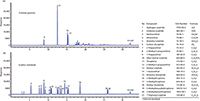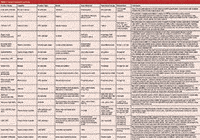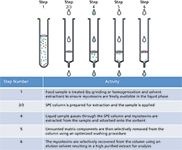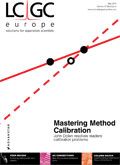New Chromatography Columns and Accessories at Pittcon 2014 (Part 2)
LCGC Europe
Part 2 of our yearly report on new products introduced at Pittcon. This instalment of "Column Watch" covers GC columns, SFC columns, and products for sample preparation including small benchtop instruments.
Part 2 of our yearly report on new products introduced at Pittcon. This instalment of "Column Watch" covers gas chromatography columns, supercritical fluid chromatography columns, and products for sample preparation, including small benchtop instruments.
Pittcon 2014 Conference and Expo (less formally known as the 65th Pittsburgh Conference on Analytical Chemistry and Applied Spectroscopy) was held once again in the gigantic McCormick Place in Chicago, Illinois, USA on 2–6 March 2014. The purpose of this report is to provide information about many of the new separation consumables and accessory products that were displayed at Pittcon 2014. In some cases, products that were introduced during 2013 but after Pittcon 2013 (1,2) may be included for reasons of completeness. The information is based on manufacturers' responses to a questionnaire mailed in early 2014. Because of space limitations and the fact that some manufacturers did not respond to the questionnaire, this report cannot be considered an exhaustive listing of all new products that were introduced in Chicago. However, over the years, these Pittcon introduction summaries have provided a good source of information that would be difficult for one individual to gather during the four days of the exhibition. In addition, the products introduced have shown definite correlations to current research, development, and application activity in the separation sciences.
In last month's coverage (3), I described new introductions in the areas of HPLC columns for reversed-phase LC, hydrophilic-interaction chromatography (HILIC), ion-exchange and ion chromatography, and size-exclusion chromatography (SEC). Specialty columns for specific types of analyses were also covered last month. This month, I look at gas chromatography (GC) and supercritical fluid chromatography (SFC) columns, sample preparation products, and hardware, accessories, and small tabletop instruments, mainly for sample preparation. For a synopsis of the overall trends seen at Pittcon, please refer to part 1 (3).
As in previous years, columns and other products recommended by their manufacturers primarily for biomolecule separations or sample preparation are denoted in the tables with the designation BIO. Some of these products may be used for general high performance liquid chromatography (HPLC) separations as well as for sample preparation, but their main emphasis is for biological samples.
Gas Chromatography and Supercritical Fluid Chromatography
The year 2014 was the sparsest ever for new GC column introductions. Only two manufacturers supplied data on their new columns for Pittcon: Agilent Technologies and J&K Scientific.
Agilent's offerings included a new line of porous open tubular (PLOT) capillary columns called PLOT PT. These unique columns virtually eliminate particle shredding through an integrated particle trapping technology on both ends of the column — giving the advantage of no need for cumbersome (and leaky) unions or downstream filters. The integrated particle trap is built directly into the column as one continuous length of fused silica. Overall, signal spiking and unnecessary downtime because of loose particles in the flow stream is less of a concern in the analysis of light gases and volatile organic compounds (VOCs), which are major applications of PLOT columns.
Agilent's second introduction in the GC area was the J&W DB-Sulphur SCD column. With dimensions of 40, 60, or 70 m × 0.32 or 0.53 mm and a film thickness of 0.75–4.3-µm, the DB-Sulphur SCD column is designed to work with sulphur chemluminescence detection (SCD) to provide lower bleed performance than polydimethylsiloxane (PDMS) phases such as ASTM D 5623 and 5504. These phases typically bleed, causing SCD ceramic tube fouling and thus more downtime and maintenance requirements. The new phase also provides improved peak shape compared to older phases. Custom configurations are available. To illustrate the capability of this new column, Figure 1 shows a separation of an actual cracked gasoline sample, along with sulphur compound standards that contain about 63.5% aromatic hydrocarbons and 25% nonaromatic hydrocarbons. Monitoring sulphur compounds in petroleum-related products is very important to protect expensive catalysts and to ensure product quality. Individual sulphur compounds in the cracked gasoline sample were identified by retention times and confirmed by gas chromatography–mass spectrometry (GC–MS). In the example of Figure 1, the very selective Sulphur Chemiluminescence Detector (SCD, Agilent Technologies) was used. It should be noted that trace levels of these volatile sulphur compounds are very difficult to detect and successful analysis requires a very inert flow path and a low-bleed stationary phase.

Figure 1: Chromatograms of (a) a cracked gasoline sample and (b) sulphur compound standards. Column: 60 m à 0.32 mm, 4.2-µm df Agilent J&W DB-Sulphur SCD; carrier gas: helium, constant flow at 2.8 mL/min; inlet temperature: 275 °C; split ratio: 10:1; oven temperature programme: 35 °C for 3 min, 35â250 °C at 10 °C/min, then 250 °C for 10 min; injection volume: 1 µL. (Courtesy of Agilent Technologies).
J&K Scientific is a Canadian company based in Nova Scotia that makes specialty columns. The company's newest introduction is the NSP-EUPAH GC capillary column. This column has wall-coated proprietary stationary phase designed to separate EU and US EPA priority polynuclear aromatic hydrocarbon (PAH) analysis. The column can provide baseline separation of the EU 15 + 1 PAH on short columns of lengths of 8–15 m with analysis times of 25–40 min. Some unique characteristics are complete separation of triphenylene from chrysene (resolution >10) and benz(a)anthracene. The column can also provide a separation of critical isomer pairs of US EPA Method 610 Priority Pollutant PAH method. In all, separation of 32 EU and US EPA priority compounds with interfering compounds and isomers can be achieved.
One dedicated column for SFC was introduced by ES Industries. Typical of columns specific to SFC, the GreenSep Triamine column resembles a regular HPLC column but with a special triamine bonded phase that is not normally used in LC. The silica-based bonded phase material (120 Å pore size) can be purchased in stainless steel packed columns in sizes ranging from microbore to preparative, as well as is in guard column format and in bulk. Particle sizes range from 1.9-µm to 20-µm. It is recommended for the separation of polar compounds such as amines without the use of additives in the mobile phase.
Sample Preparation Products
As indicated in Table 1, Pittcon 2014 was another productive year with 17 new sample preparation products or families of products displayed. Not counted here are the sample preparation accessories (Table 2) or sample preparation benchtop instruments (Table 3) that are covered later. The most popular application areas included protein and phospholipid removal from biological fluids and pesticides and toxins in food. Formats included cartridges, 96- and 48-well plates, stainless steel columns, and pipette tips.

Table 1: Sample preparation products.
Many of the products were for solid-phase extraction (SPE) and just about every mode (reversed phase, strong and weak anion and cation exchange, affinity, molecularly imprinted, adsorption and normal phase, partition, and mixed mode) was represented. Various media were introduced at Pittcon including polymer-based media, graphitized carbon black, carbon on Florisil, pepsin on silica hybrid, silica-based bonded phases, bare silica, zirconia, and diatomaceous earth.

Table 2: Chromatography and sample preparation accessories.
This year, sample preparation introductions were dominated by the 96-well plate format; obviously these products are destined for those interested in the application of automation. Very few chemists would have the patience to manually work with such tiny wells performing SPE, filtration, protein crashing, and other liquid-handling operations. If one doesn't have a robotic system, there are manual handheld multichannel pipettors that relieve some of the tedium. One interesting plate that was introduced by Tecan has an immobilized stationary phase inside each well. Thus, a form of SPE or liquid–liquid partition can be performed by using the well as a small extraction vessel. An aqueous solution is first introduced and, depending on the stationary phase, analytes can be sorbed onto the immobilized coating. Then, after a washing step, an organic solvent is introduced that desorbs the sorbed analytes, which can then be injected into a chromatographic or electrophoretic system.

Table 3: Sample preparation instrumentation.
Both single-tube and 96-well plate filtration devices are available for protein "crashing" experiments. Rather than using SPE and spending time developing methods, the trend in recent years has been to precipitate (crash) proteins out of biological fluids (such as plasma) by adding an organic solvent like acetonitrile. The precipitated proteins can be removed by centrifugation (somewhat time-consuming) or can be filtered through a membrane filter and the supernatant can be analyzed by LC–MS–MS for the drugs and other compounds. Several new products were introduced that not only perform the protein precipitation but will also remove troublesome phospholipids by the use of special media, sometimes based on zirconia or titania but more often referred to as proprietary, that will remove or substantially reduce the lipid content. Phospholipids are notorious for causing signal suppression in MS and their removal provides improved sensitivity and selectivity. To illustrate the mechanism of phospholipid retention, Figure 2 shows the design of the packed wells of a 96-well plate (left-hand side) along with a depiction of the interactions of a phospholipid with the zirconia-coated silica surface (right-hand side).

Figure 2: Retention mechanism of hybrid phospholipid SPE sorbent for separating hydrophobic analytes from phospholipid contaminants in biological sample matrices. (Courtesy of Supelco/Sigma-Aldrich).
Additional products for QuEChERS were introduced at Pittcon 2014. This method is an emerging technique that is becoming increasingly popular in the area of multiresidue pesticide analysis in food and agricultural products. In QuEChERS, food or agricultural samples are first extracted with an aqueous miscible solvent (such as acetonitrile) in the presence of high amounts of salts (for example, sodium chloride and magnesium sulphate) or buffering agents (such as citrate) to induce liquid phase separation and stabilize acid- and base-labile pesticides. After shaking and centrifugation, an aliquot of the organic phase is subjected to further cleanup using SPE. Unlike traditional methods using SPE tubes, dispersive SPE (dSPE) cleanup is conducted by mixing bulk amounts of SPE sorbent and additional magnesium sulphate with the extract. After sample cleanup, the mixture is centrifuged and the resulting supernatant can either be analyzed directly or subjected to minor further treatment before analysis.
A most interesting product for dSPE was shown. Pigments in fruit and vegetable samples are mostly removed during the second QuEChERS extraction step by the use of graphitized carbon black (GCB). This substance is rather messy to work with because it sticks to the edges of the extraction container and sometimes particles remain suspended, but a bigger problem is that, besides removing chlorophyll and other pigments, it also removes planar pesticides. An additional step with toluene extraction is required to recover these pesticides, but some of the pigment also gets back into the solution during the process. United Science introduced the CarbonX COF product, where the carbon is deposited on a Florisil substrate. It is denser than GCB and thus settles out of solution, but its main claim to fame is that it will not extract the planar pesticides. In official methods such as the AOAC 2007.01 QuEChERS method, it can be substituted directly for GCB.
Mycotoxins are particularly harmful in our food supply. Normally, expensive and problematic selective immunosorbents are required for their isolation from food extracts. Two new products appeared at Pittcon that do not require immunoaffinity methods. One is based on molecularly imprinted polymers, which is an area that is getting more attention; these sorbents are among the most selective (see Table 1). To illustrate the simplicity of some of these newer methods for mycotoxin analysis, Figure 3 provides the workflow for the isolation of mycotoxins from food samples using simple flow-through Isolute Myco SPE columns from Biotage. A large number of mycotoxins have been quantified in a variety of matrices. Methods have been developed that meet the maximum residue limits set down by EU and US regulations in terms of detection limits, percent relative standard deviation (%RSD), and recoveries.

Figure 3: Workflow for solid-phase extraction of mycotoxins from food samples using the Isolute Myco sorbent. (Courtesy of Biotage).
Chromatography and Sample Preparation Accessories
New hardware products and accessories designed to make the life of the chromatographer easier are always popular introductions at Pittcon. This year I have separated the columns and sample preparation accessories (Table 2) and small benchtop dedicated instruments that are designed to automate sample preparation and other chromatographic techniques (Table 3). Each area is covered individually.
General Chromatography Products: Airtight, inert containers for frozen samples are important in many laboratories and a whole family of such products were noted. Vials are always in big demand in the chromatography laboratory and an interesting vial closure system has been developed that prevents evaporation of solvent while vials are sitting in the autosampler.
HPLC, UHPLC, and Ion Chromatography Products: The advent of UHPLC has spurred an increasing number of ultrahigh-pressure products. This year additional high-pressure components included fittings and bio-inert columns (both stainless steel and PEEK), reusable fittings, high-pressure seals, and a high-pressure injection valve. A new guard column holder that allows the user to replace a guard column without disconnecting the inlet and outlet fluid connections was displayed. Eluent suppression in ion chromatography is often required to achieve optimum sensitivity, and a new electrolytically regenerated suppressor was introduced by Thermo Fisher Scientific this year.
GC Products: A high-pressure gas switching system was introduced that will automatically switch between two high-pressure lines, useful for a bank of gas cylinders. Nobody wants to work directly with toxic volatiles in the GC laboratory. A gas permeation tube for phosgene was introduced. A permeation tube provides a steady, low concentration of a volatile analyte that can be used for calibration and other purposes. Probably the most practical item introduced in the GC accessory market is Agilent's self-tightening stainless steel column nut. Graphite–polyimide ferrules favoured by gas chromatographers using GC–MS are notorious for requiring occasional retightening when they are cycled through repeated temperature programming operations. Otherwise, they leak, which is not good for oxygen-sensitive columns or detection methods such as MS and electron-capture detection. The new column nut has a novel spring-driven piston that continuously applies pressure to the ferrule, which prevents it from becoming loose after temperature programming cycles.
Sample Preparation: In addition to the new sample preparation products from Table 1, a new series of QuEChERS standards were introduced by Restek. These are mainly popular pesticides that are encountered in fruit and vegetable samples.
Sample Preparation Instrumentation
Table 3 shows 21 new products, mostly for sample preparation. Sample preparation still represents a major bottleneck in the laboratory because it is often a manual operation. Small benchtop instruments that automate some of the manual sample preparation steps can save time, eliminate tedium, and reduce errors. In this section, I cover benchtop instruments that range from robotic designs that perform multiple sample preparation procedures on small sample volumes to instruments that perform a single task such as solvent evaporation or mixing.
Common sample preparation tasks such as evaporation, grinding, milling, shaking, mixing, cell lysing, and centrifugation can be performed by relatively simple automated instruments that aren't going to break the bank cost-wise. Of course, for some grinding and milling tasks, fairly heavy machinery may be needed to break up rocks, plastics, or other hard substances into a powder form that can be extracted, and these may be costly. Table 3 covers a number of these dedicated benchtop devices for routine sample preparation operations.
Among the more sophisticated devices covered in Table 3 is one that automates SPE by handling as many as eight samples simultaneously. SPE has several experimental steps in its operation, and to automate all of them requires a good bit of manipulation of solvents, cartridges, and gas flows (for drydown). Supercritical fluid extraction (SFE) appears to be making a comeback, and one new device for large-scale SFE was introduced.
For GC, there are several products covered in Table 3. Simple low-cost leak detectors and flowmeters are particularly useful when performing GC analysis. On the more expensive side, a new headspace sampler was shown at Pittcon and another hydrogen generator. The latter are becoming even more popular since the world seems to be going from helium to hydrogen as the sources of helium dry up.
Acknowledgement
I would like to thank the manufacturers and distributors that kindly furnished the requested information in advance of Pittcon 2014, thus allowing a timely report on new product introductions. For those manufacturers who would like to be considered for inclusion into Pittcon 2015 coverage, please send the name of the primary company contact, the mailing address, phone number, and e-mail address to Laura Bush, Editorial Director, LCGC Europe, lbush@advanstar.com, with the subject line "Pittcon 2015 Column Watch."
"Column Watch" Editor Ronald E. Majors is an analytical consultant and is a member of LCGC Europe's editorial advisory board. Direct correspondence about this column should be addressed to "Column Watch", LCGC Europe, 4A Bridgegate Pavilion, Chester Business Park, Wrexham Road, Chester, CH4 9QH, UK, or e-mail the editor-in-chief, Alasdair Matheson, at amatheson@advanstar.com
References
(1) R.E. Majors, LCGC North Am. 31(4), 280–298 (2013).
(2) R.E. Majors, LCGC North Am. 31(5), 364–381 (2013).
(3) R.E. Majors, LCGC North Am. 27(4), 196–207 (2014).

New Method Explored for the Detection of CECs in Crops Irrigated with Contaminated Water
April 30th 2025This new study presents a validated QuEChERS–LC-MS/MS method for detecting eight persistent, mobile, and toxic substances in escarole, tomatoes, and tomato leaves irrigated with contaminated water.

.png&w=3840&q=75)

.png&w=3840&q=75)



.png&w=3840&q=75)



.png&w=3840&q=75)









